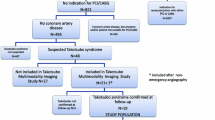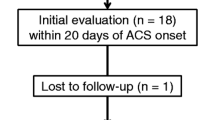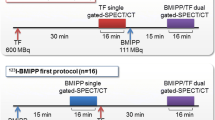Abstract
Background. In patients with ischemic left ventricular (LV) dysfunction, myocardial perfusion imaging after nitrate administration may improve the identification of dysfunctional but viable myocardium. This study was designed to assess the relationship between tetrofosmin uptake after nitrate administration and metabolic activity as assessed by positron emission tomography (PET) in patients with ischemic LV dysfunction.
Methods and Results. Thirty-six patients with chronic myocardial infarction and LV dysfunction (ejection fraction, 35% ± 6%) underwent resting technetium 99m tetrofosmin single photon emission computed tomography (SPECT) imaging under control conditions (baseline) and after sublingual administration of 10 mg isosorbide dinitrate. Within 1 week, all patients underwent metabolic PET imaging with fluorine 18-fluorodeoxyglucose. Tetrofosmin uptake and metabolic activity were measured in 13 segments/patient. Regional LV function was assessed in corresponding segments by echocardiography. On baseline tetrofosmin imaging, 53 (40%) of the 131 akinetic or dyskinetic segments had reduced (<55% of peak activity) tracer uptake. Of these segments, 14 (26%) showed enhanced tetrofosmin uptake after nitrate administration (≥10% vs baseline) and the remaining 38 (74%) did not change. The sensitivity and specificity of baseline tetrofosmin SPECT for detecting preserved metabolic activity were 69% and 86%, respectively. After nitrate administration, the sensitivity was higher (81%, P < .05 vs baseline) whereas the specificity was not different (86%, P = not significant). Concordance between tetrofosmin SPECT and PET in differentiating viable and necrotic myocardium was observed in 94 (72%) of the 131 akinetic or dyskinetic segments at baseline (k = 0.35) and in 108 segments (82%) after nitrate administration (k = 0.53).
Conclusions. After nitrate administration, tetrofosmin uptake in dysfunctional segments correlated with metabolic activity as assessed by fluorodeoxyglucose PET imaging better than baseline. Thus tetrofosmin SPECT after nitrate administration may improve the identification of ischemic but still viable myocardium in patients with chronic ischemic LV dysfunction. (J Nucl Cardiol 2003;10:599-606.)
Similar content being viewed by others
References
Patterson RE, Pilcher WC. Assessing myocardial viability to help select patients for revascularization to improve left ventricular dysfunction due to coronary artery disease. Semin Thorac Cardiovasc Surg 1995;7:214–26.
Ragosta M, Beller GA. The noninvasive assessment of myocardial viability. Clin Cardiol 1993;16:531–8.
Marwick TH, Zuchowski C, Lauer MS, et al. Functional status and quality of life in patients with heart failure undergoing coronary bypass surgery after assessment of myocardial viability. J Am Coll Cardiol 1999;33:750–8.
Paeng JC, Lee DS, Cheon GJ, et al. Consideration of perfusion reserve in viability assessment by myocardial Tl-201 rest-redistribution SPECT: a quantitative study with dual-isotope SPECT. J Nucl Cardiol 2002;9:68–74.
Saha GB, MacIntyre WJ, Brunken RC, et al. Present assessment of myocardial viability by nuclear imaging. Semin Nucl Med 1996; 26:315–35.
Bonow RO, Dilsizian V, Cuocolo A, Bacharach S. Identification of viable myocardium in patients with chronic coronary artery disease and left ventricular dysfunction. Comparison of thallium scintigraphy with reinjection and PET imaging with 18F-fluorodeoxyglucose. Circulation 1991;83:26–37.
Bax J, Wijins W. Fluorodeoxyglucose imaging to assess myocardial viability: PET, SPECT or gamma camera coincidence imaging? J Nucl Med 1999;40:1893–5.
Yoshinaga K, Morita K, Yamada S, et al. Low-dose dobutamine electrocardiography-gated myocardial SPECT for identifying viable myocardium: comparison with dobutamine stress echocardiography and PET. J Nucl Med 2001;42:838–44.
Acampa W, Cuocolo A, Petretta M, et al. Tetrofosmin imaging in the detection of myocardial viability in patients with previous myocardial infarction: comparison with sestamibi and Tl-201 scintigraphy. J Nucl Cardiol 2002;9:33–40.
Matsunari I, Fujino S, Taki J, et al. Myocardial viability assessment with technetium-99m tetrofosmin and thallium-201 reinjection in coronary artery disease. J Nucl Med 1995;36: 1961–7.
Udelson JE, Coleman PS, Metherall J, et al. Predicting recovery of severe regional ventricular dysfunction: comparison of resting scintigraphy with 201-thallium and 99mTc-sestamibi. Circulation 1994;89:2552–61.
Sciagrà R, Leoncini M, Marcucci G, Dabizzi RP, Pupi A. Technetium- 99m sestamibi imaging to predict left ventricular ejection fraction outcome after revascularization in patients with chronic coronary artery disease and left ventricular dysfunction: comparison between baseline and nitrate enhanced imaging. Eur J Nucl Med 2001;28:680–7.
Derebek E, Kozan O, Durak H, et al. Sublingual nitrate plus 99mTc-tetrofosmin infusion in the detection of severely ischaemic but viable myocardium: a comparative study with stress, redistribution, reinjection and late redistribution 201Tl imaging. Nucl Med Commun 1996;17:864–71.
Cuocolo A, Acampa W, Nicolai E, et al. Quantitative thallium-201 and technetium 99m sestamibi tomography at rest in detection of myocardial viability in patients with chronic ischemic left ventricular dysfunction. J Nucl Cardiol 2000;7:8–15.
Leoncini M, Marcucci G, Sciagrà R, et al. Usefulness of distinct activity thresholds according to baseline regional asynergy for predicting functional recovery in patients with chronic coronary artery disease and left ventricular dysfunction: a study with nitrate-enhanced sestamibi gated SPECT. J Nucl Cardiol 2001;8: 555–60.
Cuocolo A, Petretta M, Nicolai E, et al. Successful coronary revascularization improves prognosis in patients with previous myocardial infarction and evidence of viable myocardium at thallium-201 imaging. Eur J Nucl Med 1998;25:60–8.
Cohen J. A coefficient of agreement for nominal scales. Educ Psychol Meas 1960;20:37–46.
Fleiss JL. Statistical methods for rates and proportions. New York: Wiley and Sons; 1981. p. 217–25.
Baer FM, Erdmann E. Methods of assessment and clinical relevance of myocardial hibernation and stunning. Assessment of myocardial viability. Thorac Cardiovasc Surg 1998;46(Suppl 2): 264–9.
He ZW, Verani MS, Liu XJ. Nitrate-augmented myocardial imaging for assessment of myocardial viability. J Nucl Cardiol 1995; 2:352–7.
Miyanaga H, Kunieda Y, Oguni A, et al. Improved detection of fill-in using sublingual nitroglycerin in technetium-99m tetrofosmin exercise/rest single protocol for old myocardial infarction. J Cardiol 1999;33:135–43.
Oudiz RJ, Smith DE, Pollak AJ, et al. Nitrate-enhanced thallium 201 single-photon emission computed tomography imaging in hibernating myocardium. Am Heart J 1999;138:369–75.
Wadhwa SS, Mansberg R, Fernandes VB. Tl-201 myocardial perfusion SPECT: role of nitrate-augmented redistribution. Clin Nucl Med 1999;24:1–5.
Flotats A, Carrio I, Estorch M, et al. Nitrates administration to enhance the detection of myocardial viability by technetium-99m tetrofosmin single-photon emission tomography. Eur J Nucl Med 1997;24:767–73.
Thorley PJ, Sheard KL, Wright DJ, Sivananthan UM. The routine use of sublingual GTN with resting 99m-Tc-tetrofosmin myocardial perfusion imaging. Nucl Med Commun 1998;19:937–42.
Abrams J. Hemodynamic effects of nitroglycerin and long-acting nitrates. Am Heart J 1985;110:216–24.
Brown BG, Bolson E, Peterson RB, Pierce CD, Dodge HT. The mechanisms of nitroglycerin action: stenosis vasodilation as a major component of the drug response. Circulation 1981;64:1089–97.
Aoki M, Sakai K, Koyanagi S, Takeshita A, Nakamura M. Effect of nitroglycerin on coronary collateral function during exercise evaluated by quantitative analysis of thallium-201 single photon emission computed tomography. Am Heart J 1991;121:1361–6.
He ZX, Medrano R, Hays JT, Mahmarian JJ, Verani MS. Nitroglycerin- augmented Tl-201 reinjection enhances detection of reversible myocardial hypoperfusion. A randomized, double-blind, parallel, placebo-controlled trial. Circulation 1997;95:1799–805.
Cohn PF, Maddox D, Holman BL, et al. Effect of sublingually administered nitroglycerin on regional myocardial blood flow in patients with coronary artery disease. Am J Cardiol 1977;39:672–8.
Fallen EL, Nahmias C, Scheffel A, et al. Redistribution of myocardial blood flow with topical nitroglycerin in patients with coronary artery disease. Circulation 1995;91:1381–8.
Mahmarian JJ, Fenimore NL, Marks GF, et al. Transdermal nitroglycerin patch therapy reduces the extent of exercise-induced myocardial ischemia: results of a double-blind, placebo-controlled trial using quantitative thallium-201 tomography. J Am Coll Cardiol 1994;24:25–32.
He ZX, Kou RW, Liu XJ. Measurements of the effects of percutaneous nitroglycerin on left ventricular performance in patients with coronary artery disease with a cardiac probe. Eur J Nucl Med 1988;14:374–7.
Lahiri A, Crawley JC, Sonecha TN, Raftery EB. Acute and chronic effects of sustained action buccal nitroglycerin in severe congestive heart failure. Int J Cardiol 1984;5:39–48.
Matsunari I, Boning G, Ziegler SI, et al. Attenuation-corrected Tc-99m tetrofosmin single-photon emission computed tomography in the detection of viable myocardium: comparison with positron emission tomography using F-18 fluorodeoxyglucose. J Am Coll Cardiol 1998;32:927–35.
Mabuchi M, Kubo N, Morita K, et al. Prediction of functional recovery after coronary bypass surgery using quantitative gated myocardial perfusion SPECT. Nucl Med Commun 2003;24:625–31.
Author information
Authors and Affiliations
Corresponding author
Rights and permissions
About this article
Cite this article
He, W., Acampa, W., Mainolfi, C. et al. Tc-99m tetrofosmin tomography after nitrate administration in patients with ischemic left ventricular dysfunction: Relation to metabolic imaging by PET. J Nucl Cardiol 10, 599–606 (2003). https://doi.org/10.1016/S1071-3581(03)00649-4
Received:
Accepted:
Issue Date:
DOI: https://doi.org/10.1016/S1071-3581(03)00649-4




